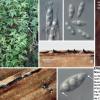
14-11-2025 18:31
 Lothar Krieglsteiner
Lothar Krieglsteiner
Hello,can somebody provide me with a file of:Rothe

14-11-2025 16:26
 Marian Jagers
Marian Jagers
Hello everyone, On dead wood of Cytisus scoparius

12-11-2025 09:25
 Viktorie Halasu
Viktorie Halasu
Hello, I need help with a pale terrestric Pseudom

11-11-2025 20:16
Bohan JiaHi, lastly I have found these tiny yellow decayin

09-11-2025 13:20
Hello.A tiny ascomycete, appearing as erupting gra

08-11-2025 00:29
 Francois Guay
Francois Guay
I found this species in Quebec, Canada, on herbace
Diaporthe trinucleata - rare or overlooked?
Chris Yeates,
21-07-2021 20:01

Bonsoir tous
I recently collected some dead stems of Eupatorium cannabinum with the purpose of producing a composite image of Plenodomus agnitus (= Leptosphaeria agnita) which is common on that host in this area.
I noticed that among the numerous pseudothecia of that fungus there were much scarcer smaller fruitbodies mostly immersed in the host plant's cortex, and with pointed necks very different from the shallowly domed Plenodomus. From the apical ascal structure it was clear that this a member of the Diaporthales, and probably a member of the Diaporthaceae.
Having recently written up the Diaporthales for an ongoing Yorkshire Mycota I fully appreciate the nomenclatural and taxonomic issues with that order and might well have moved on. However there were a couple of interesting features: one was the complete lack of a septum, which pointed to what would at one time have suggested a member of Diaporthopsis (now sunk into Diaporthe), and the other was the high proportion (>90%) of spores containing three large guttules. Searching through Munk (1957) and Wehmeyer (1933) indicated that there was such a species and that it was a Eupatorium specialist - Diaporthe trinucleata Niessl. So I am quite happy to use that name for this collection, although I appreciate that sequencing might in future shed more light on this. Of interest is that on a few of the spores a hyaline conical appendage at each end of the spore could just be made out - easier to see than to photograph! Munk mentions no such feature and Wehmeyer specifically states he didn't see it, but Niessl in his protologue mentions "...utrinque obtusiusculis breve mucronatis hyalinis...".
I shall certainly keep an eye out for this taxon on further encounters with Eupatorium, and wondered whether anyone else had found it?
Cordialement, Chris
Thomas Læssøe,
21-07-2021 20:58
Re : Diaporthe trinucleata - rare or overlooked?
I have made two Danish records on this species on that host (no notes available on the database, maybe with the material)
cheers
Thomas
cheers
Thomas
Chris Yeates,
23-07-2021 14:18

Re : Diaporthe trinucleata - rare or overlooked?
Thanks for that Thomas. So the host relationship seems consistent - do you find Plenodomus agnitus to be rather common on Eupatorium in Denmark as well?
kind regards, Chris

